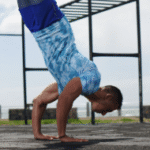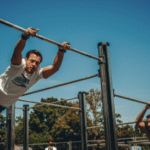Master the Muscle-Up: Targeted Training with a Calisthenics Coach
In the world of calisthenics, few skills are as iconic as the muscle-up. It’s the ultimate test of upper body power, seamlessly blending a powerful pull with a strong push. For many athletes in Houston, achieving a clean, strict muscle-up is a benchmark of true bodyweight mastery. However, it’s also a highly technical skill where improper training can lead to months of frustration and serious shoulder or elbow injuries.
This is why targeted training with a private calisthenics coach is the gold standard for unlocking this skill. A coach provides the roadmap, corrects the technical flaws, and ensures you build the necessary strength safely. Here’s a detailed look at how a coach will guide you on your journey to mastering the muscle-up.
Deconstructing the Beast: The Three Phases of the Muscle-Up
A coach will first teach you that the muscle-up isn’t one movement, but three distinct phases that must be trained both separately and together:
The Explosive Pull: This is not a standard pull-up. You need to pull your body high and fast enough to get your center of gravity up over the bar.
The Transition: This is the most technical and often most difficult part of the movement. It involves rolling your shoulders over the bar to move from a pulling position to a pushing position.
The Straight-Bar Dip: The final phase requires the strength to push your body up from the bottom of a deep dip to a full lockout at the top.
Phase 1: Earning the Right to Train (The Prerequisite Strength)
Before you even attempt a muscle-up, a good coach will put you through a rigorous assessment to ensure you have the foundational strength. This is non-negotiable and is the most important step in preventing injury.
The Strength Benchmarks You Must Meet:
Clean Pull-ups: You should be able to perform 10-15 consecutive, perfect-form pull-ups. This means full range of motion (from a dead hang to chin clearly over the bar) with no kipping or swinging.
Deep Dips: You need to be able to do 15-20 consecutive, deep straight-bar dips. Your shoulders should go below your elbows at the bottom of the movement.
Chest-to-Bar Pull-ups: This is the true test of explosive power. You should be able to perform at least 3-5 explosive pull-ups where your lower chest makes contact with the bar.
If you can’t meet these numbers, your coach will focus your training here first. This phase is all about building the raw strength needed to handle the demands of the muscle-up.
Phase 2: Drilling the Components (Your Targeted Training Plan)
Once you have the prerequisite strength, your coach will introduce specific drills to target each phase of the muscle-up.
- For the Explosive Pull:
Weighted Pull-ups: Adding weight is the most effective way to increase your pulling power. Your coach will have you work in lower rep ranges (3-5 reps) with added weight.
Band-Resisted Pull-ups: This teaches you to accelerate through the entire range of motion, as the band’s resistance increases the higher you pull.
- For the Transition:
Negative Muscle-ups: This is the single most important drill for learning the transition. You’ll start at the top of the muscle-up (in the dip support position) and lower yourself down as slowly and controlled as possible through the transition phase and into the hang. This builds immense strength and muscle memory in the exact pattern you need.
Jumping Muscle-ups: From the ground, you’ll use your legs to jump into the movement, giving you just enough assistance to get over the bar. Your coach will ensure you use as little leg drive as possible, forcing your upper body to do the work.
- For the Dip:
Weighted Dips: Just like with pull-ups, adding weight to your dips will build the raw pushing power needed to finish the movement strong.
Paused Dips: Your coach will have you pause at the very bottom of the dip for 2-3 seconds. This builds strength in the most difficult part of the movement.
Understanding the “False Grip”
Your coach will almost certainly teach you the false grip. This is where you place the heel of your palm on top of the bar, with your wrist flexed over it. While it feels awkward at first, this grip positions your wrist to roll over the bar much more easily during the transition. Mastering the false grip is often the final key that unlocks the muscle-up.
Phase 3: Putting It All Together
When your coach sees that you have mastered the individual components, they will guide you through your first full attempts, typically using assistance.
Band-Assisted Muscle-ups: By looping a heavy resistance band over the bar and under your feet, you can practice the full movement with reduced body weight. This allows you to coordinate the pull, transition, and push in one fluid motion. As you get stronger, your coach will have you use progressively lighter bands until you no longer need one.
Conclusion: The Coach as Your Guide
The muscle-up is a complex skill that demands respect. A private calisthenics coach provides the expert eye to correct subtle technical flaws, the programming knowledge to build strength efficiently, and the wisdom to know when to push you and when to hold back. With their guidance, the muscle-up transforms from an intimidating feat into an achievable goal on your fitness journey.

Master the Muscle-Up: Targeted Training with a Calisthenics Coach
Route
Calisthenics Gym Houston Functional Bodyweight Training
Secondary phone: (346) 483-3195
Email: info@calisthenicsclubhouston.com
URL: https://calisthenicsclubhouston.com/
Monday 6:00 AM - 7:00 PM Tuesday 6:00 AM - 7:00 PM Open now Wednesday 6:00 AM - 7:00 PM Thursday 6:00 AM - 7:00 PM Friday 12:00 PM - 6:30 PM Saturday 9:45 AM - 12:00 PM Sunday 3:00 PM - 5:00 PM





